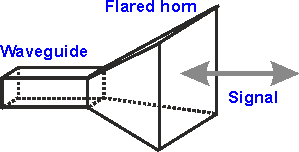Call the transmitted wave $t$ and its reflection from the metal $r$. Note first that this is a passive and reciprocal system, so the reflectivity and transmissivity are the same from both sides, $|S_{11}|=|S_{22}|$ and $|S_{12}|=|S_{21}|$. There are several discrete places where reflection may occur, starting from the left: at the $P_1$ backshort, at the $P_2$ launch probe, at the $P_3$ transition between the waveguide and the horn, and at the $P_4$ rim of the horn (I ignore the very small but continuous reflection from the wall's of the horn). When you place a sheet in front of the horn the wave $r$ will first reflect from $P_4$ the rim, then after passing into the horn it will suffer reflection from $P_3$ the transition between the waveguide and the horn, this reflection will interfere with the primary transmitted. The backshort is placed at a distance so that antenna probe in the waveguide is reasonably well matched but the match is not perfect so there will be some reflection from them. All these will contribute to the SWR and being positive SWR must be larger than one.
While it is true that the horn is an impedance transformer between the ether's $120\pi=377\Omega$ and whatever impedance the waveguide has. But no impedance match is perfect even at a single frequency, all those points $P_1,...P_4$ are potential discontinuities; a very good horn may have 40dB return loss or 1% reflectivity over a very narrow bandwidth. At any rate, over a nonzero bandwidth nothing can be matched perfectly even with lossless elements.

